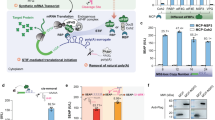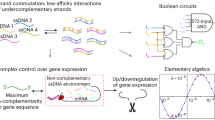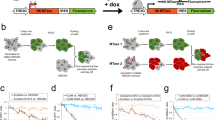Abstract
Efficient nuclear delivery of plasmid DNA represents a major barrier in nonviral gene transfer. One approach has been to use DNA-binding proteins such as GAL4 from yeast as DNA carriers with nuclear targeting properties. We recently showed, however, that GAL4 is inefficient in targeting DNA to the nucleus because its DNA-binding and nuclear targeting activities are mutually exclusive, which relates to the fact that GAL4 nuclear import occurs via a novel pathway. Here, we ‘switch’ this pathway to a more conventional one by adding a modified poly-lysine to which an optimized nuclear targeting signal, based on that of the SV40 large T-antigen, is linked. We also use a chimeric GAL4-α-melanocyte stimulating hormone (MSH) fusion protein to enable gene transfer to cells expressing the MSH receptor. Switching the nuclear import pathway of the transfecting complex significantly enhances receptor-mediated gene transfer through enabling interaction with desired components of the cellular nuclear import machinery. The present study represents the first demonstration that nuclear targeting signals can enhance receptor-mediated gene delivery, the approaches having important relevance to research and clinical applications, such as in generating transgenic or knock-out animals, or in gene therapy.
This is a preview of subscription content, access via your institution
Access options
Subscribe to this journal
Receive 6 print issues and online access
$259.00 per year
only $43.17 per issue
Buy this article
- Purchase on SpringerLink
- Instant access to full article PDF
Prices may be subject to local taxes which are calculated during checkout




Similar content being viewed by others
References
Wagner E et al. Influenza virus hemagglutinin HA-2 N-terminal fusogenic peptides augment gene transfer by transferrin–polylysine-DNA complexes: toward a synthetic virus-like gene-transfer vehicle Proc Natl Acad Sci USA 1992 89: 7934–7938
Zauner W et al. Glycerol and polylysine synergize in their ability to rupture vesicular membranes: a mechanism for increased transferrin–polylysine-mediated gene transfer Exp Cell Res 1997 232: 137–145
Chan CK, Jans DA . Enhancement of polylysine-mediated transferrinfection by nuclear localization sequences: polylysine does not function as a nuclear localization sequence Hum Gene Ther 1999 10: 1695–1702
Zanta MA, Boussif O, Adib A, Behr JP . In vitro gene delivery to hepatocytes with galactosylated polyethylenimine Bioconjug Chem 1997 8: 839–844
Midoux P, Monsigny M . Efficient gene transfer by histidylated polylysine/pDNA complexes Bioconjug Chem 1999 10: 406–411
Sosnowski BA et al. Targeting DNA to cells with basic fibroblast growth factor (FGF2) J Biol Chem 1996 271: 33647–33653
Ferkol T, Perales JC, Mularo F, Hanson RW . Receptor-mediated gene transfer into macrophages Proc Natl Acad Sci USA 1996 93: 101–105
Diebold SS et al. Efficient gene delivery into human dendritic cells by adenovirus polyethylenimine and mannose polyethylenimine transfection Hum Gene Ther 1999 10: 775–786
Kircheis R et al. Polycation-based DNA complexes for tumor-targeted gene delivery in vivo J Gene Med 1999 1: 111–120
Kollen WJ et al. High-efficiency transfer of cystic fibrosis transmembrane conductance regulator cDNA into cystic fibrosis airway cells in culture using lactosylated polylysine as a vector Hum Gene Ther 1999 10: 615–622
Baker A et al. Polyethylenimine (PEI) is a simple, inexpensive and effective reagent for condensing and linking plasmid DNA to adenovirus for gene delivery Gene Therapy 1997 4: 773–782
Paul RW et al. Gene transfer using a novel fusion protein, GAL4/invasin Hum Gene Ther 1997 8: 1253–1262
Fominaya J, Wels W . Target cell-specific DNA transfer mediated by a chimeric multidomain protein. Novel non-viral gene delivery system J Biol Chem 1996 271: 10560–10568
Silver PA, Keegan LP, Ptashine M . Amino terminus of the yeast GAL4 gene product is sufficient for nuclear localization Proc Natl Acad Sci USA 1984 81: 5951–5955
Chan CK, Huebner S, Hu W, Jans DA . Mutual exclusivity of DNA binding and nuclear localization signal recognition by the yeast transcription factor GAL4: implications for nonviral DNA delivery Gene Therapy 1998 5: 1204–1212
Gorlich D et al. Distinct functions for the two importin subunits in nuclear protein import Nature 1995 377: 246–248
Huebner S, Xiao CY, Jans DA . The protein kinase CK2 site (Ser111/112) enhances recognition of the simian virus 40 large T-antigen nuclear localization sequence by importin J Biol Chem 1997 272: 17191–17195
Schmitz ML, Baeuerle PA . A vector, pHisGal, allowing bacterial production of proteins fused to a hexahistidine-tagged Gal4 DNA-binding domain Biotechniques 1994 17: 714–716
Murphy JR et al. Genetic construction, expression, and melanoma-selective cytotoxicity of a diphtheria toxin-related alpha-melanocyte-stimulating hormone fusion protein Proc Natl Acad Sci USA 1986 83: 8258–8262
Morandini R et al. Receptor-mediated cytotoxicity of alpha-MSH fragments containing melphalan in a human melanoma cell line Int J Cancer 1994 56: 129–133
Efthymiadis A, Shao H, Huebner S, Jans DA . Kinetic characterization of the human retinoblastoma protein bipartite nuclear localization sequence (NLS) in vivo and in vitro. A comparison with the SV40 large T-antigen NLS J Biol Chem 1997 272: 22134–22139
Rexach M, Blobel G . Protein import into nuclei: association and dissociation reactions involving transport substrate, transport factors, and nucleoporins Cell 1995 83: 683–692
Imamoto N et al. In vivo evidence for involvement of a 58 kDa component of nuclear pore-targeting complex in nuclear protein import EMBO J 1995 14: 3617–3626
Eberle AN et al. Receptors for melanocyte-stimulating hormone on melanoma cells Ann NY Acad Sci 1993 680: 320–341
Chan CK, Senden T, Jans DA . Supramolecular structure and nuclear targeting efficiency determine the enhancement of transfection by NLS-containing polylysine Gene Therapy 2000 7: 1690–1697
Mellman I, Fuchs R, Helenius A . Acidification of the endocytic and exocytic pathways Annu Rev Biochem 1986 55: 663–700
Wagner E, Cotten M, Foisner R, Birnstiel ML . Transferrin–polycation-DNA complexes: the effect of polycations on the structure of the complex and DNA delivery to cells Proc Natl Acad Sci USA 1991 88: 4255–4259
Zanta MA, Belguise VP, Behr JP . Gene delivery: a single nuclear localization signal peptide is sufficient to carry DNA to the cell nucleus Proc Natl Acad Sci USA 1999 96: 91–96
Ludtke JJ, Zhang G, Sebestyen MG, Wolff JA . A nuclear localization signal can enhance both the nuclear transport and expression of 1 kb DNA J Cell Sci 1999 112: 2033–2041
Jakel S, Gorlich D . Importin beta, transportin, RanBP5 and RanBP7 mediate nuclear import of ribosomal proteins in mammalian cells EMBO J 1998 17: 4491–4502
Author information
Authors and Affiliations
Rights and permissions
About this article
Cite this article
Chan, CK., Jans, D. Enhancement of MSH receptor- and GAL4-mediated gene transfer by switching the nuclear import pathway. Gene Ther 8, 166–171 (2001). https://doi.org/10.1038/sj.gt.3301366
Received:
Accepted:
Published:
Issue date:
DOI: https://doi.org/10.1038/sj.gt.3301366
Keywords
This article is cited by
-
Histone-mediated Transduction as an Efficient Means for Gene Delivery
Molecular Therapy (2007)
-
Towards safe, non-viral therapeutic gene expression in humans
Nature Reviews Genetics (2005)
-
Nuclear entry of nonviral vectors
Gene Therapy (2005)



